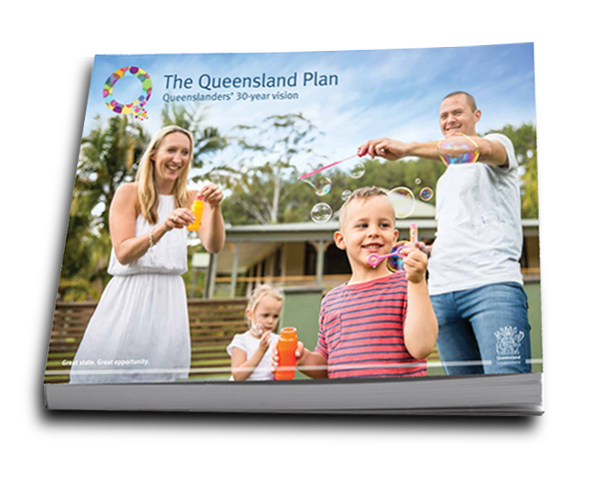Community
On this page:
- Queenslanders’ vision for our community
- Why community is a foundation
- Spotlight on our community
- What Queenslanders want
- Achieving success
- Get involved
Queenslanders’ vision for our community
In 2044, community spirit will not be a goal, it will be a way of life. Our communities will be open, welcoming and inclusive of everyone. They will work to change disadvantage and create opportunity. They will set an example to the world. Our communities will be vibrant places where we value the contribution of every Queenslander and find opportunities to enrich the lives of others. Functioning as hubs, they will connect people across the state and across the globe.
Why community is a foundation
Our vibrant communities shape Queensland’s unique character. They are places where we demonstrate our diversity and community spirit and provide vital hubs for the services and activities that connect us. Read more on page 27 of The Queensland Plan.
Spotlight on our community

What Queenslanders want
The following goals highlight what Queenslanders said they wanted to be, do or achieve (in relation to this foundation). These goals are accompanied by the outcomes Queenslanders said they want to see. Read detailed descriptions of success factors in The Queensland Plan.
| Goal | What does success look like? |
|---|---|
| G5 In Queensland nobody gets left behind. |
Those in need have equal access to community and social services and supporting infrastructure. |
| Queensland has places, spaces and activities that encourage participation. | |
| We take responsibility for our actions and value community spirit. | |
| G6 We celebrate, embrace and respect diversity. |
Cultural diversity is appreciated by all. |
| Queensland will be an inclusive society with strong community values. | |
| G7 We applaud community achievers. |
Parents and schools will instil values and aspirations. |
| Children and young people know the value of education and take initiative. | |
| Local skills and resources are highly sought after. | |
| Queenslanders are renowned for volunteering and community participation. |
Achieving success
The following targets and measures will help focus our efforts towards achieving success. The baselines have been sourced from existing data sets as a starting point for future reporting. Download The Queensland Plan for a detailed explanation of what the measures show.
T4 Household prosperity
Increase the wealth of all Queenslanders while achieving Australia’s narrowest gap between the wealthy and the poor.
T5 Opportunity for all
Anyone who makes Queensland their home has meaningful employment opportunities and participates in their community.
T6 Community connection
Queensland has the highest rates of volunteering and community participation in Australia.
| Primary measure | Starting point or baseline | ||||
|---|---|---|---|---|---|
Household prosperityMedian net worth of Queensland households relative to Australia. Source: ABS 6523.0 (2013), Household Income and Income Distribution, Australia–Detailed tables, 2011–12.
|
Baseline: Median net worth of Queensland households, 2011–12. The net worth of Queensland households is 9.1% lower than the Australian median. |
||||
Income equityRatio of income share received by bottom 20% of households relative to the top 20% of households. Source: ABS 6523.0 (2013), Household Income and Income Distribution, Australia – Detailed tables, 2011–12.
|
Baseline: 2011–12. The top 20% of households have 5.3 times the household disposable income of the bottom 20% of households. |
||||
Employment opportunityRate of labour force participation for migrants compared with the rest of Australia. Source: ABS 6291.055.001 Labour Force, Australia, Detailed-Electronic Delivery, Labour Force Status – By Country of Birth.
|
Baseline: Labour force participation rate of Queenslanders, 2012–13. |
||||
Volunteering by age groupRate of participation in voluntary work by age group, compared with Australia. Source: ABS Census of Population and House, 2011.
|
Baseline: Queenslanders 18 years or older doing unpaid voluntary work through an organisation or group compared with Australia, 2011. |
| Secondary measure | Starting point or baseline | ||||
|---|---|---|---|---|---|
Employment barriersUnemployment rates of persons born in non-English speaking countries, arriving in the past five years. Source: ABS Census of Population and Housing, 2011.
|
Baseline: Unemployment rates of Queenslanders born in a non-English speaking country who arrived between 2006 and 2011. Published 2011. |
||||
Volunteering by originRate of participation in voluntary work by migrant status. Source: ABS Census of Population and Housing, 2011.
|
Baseline: Unpaid voluntary work through an organisation or group, 2011. |
||||
Community connectionProportion of Queensland residents who were born overseas and not proficient in English having face-to-face contact with family and friends living outside the household in the past week. Source: ABS 4159.0.55.0003 (2012), General Social Survey: States and Territories, 2010.
|
87.6% face-to-face contact with family or friends. Baseline: Queensland residents born overseas and not proficient in English have face-to-face contact with family or friends living outside the household, 2010. |
Return to the foundations landing page to understand the purpose of the targets and measures or to select another foundation area to learn about.
Get involved
There are many ways you can help achieve our vision. Visit our Get involved page to read a few suggestions related to each foundation area.




